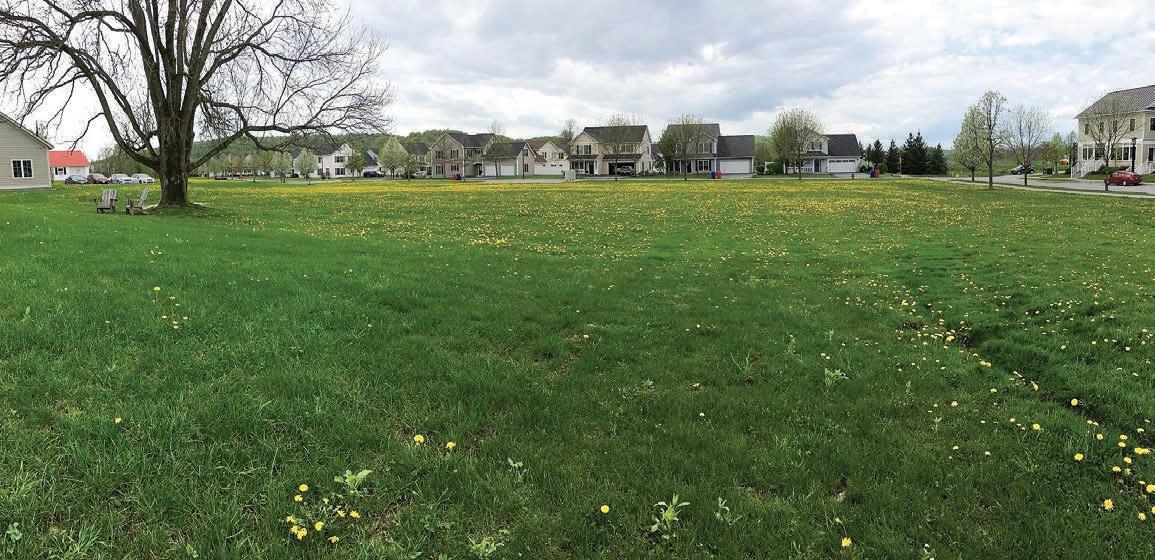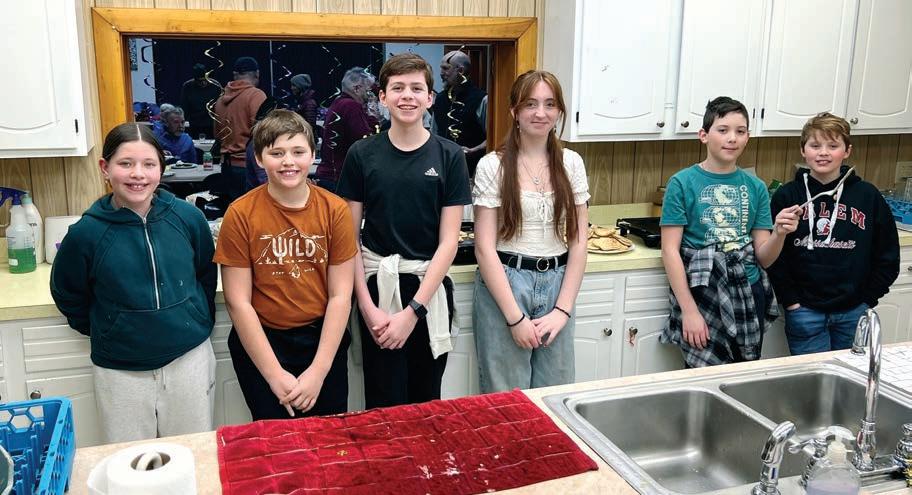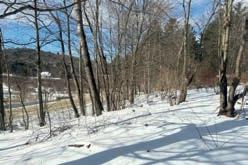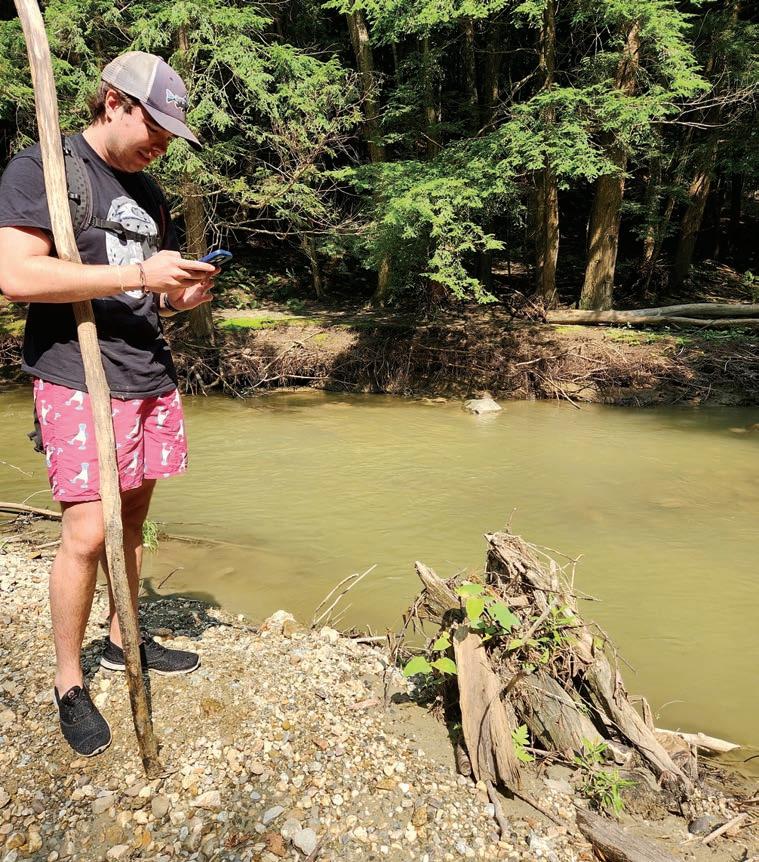Double down
Redhawk alpine teams win back-to-back ski titles for boys and girls

Page 10 Shelf help
Choosing the right way to showcase plants key to their health, too
Page 11


Double down
Redhawk alpine teams win back-to-back ski titles for boys and girls

Page 10 Shelf help
Choosing the right way to showcase plants key to their health, too
Page 11

Despite the difficulty of waking up the Monday morning after daylight savings begins, Champlain Valley School District’s board and local legislators met in the high school library at 7:30 a.m. for their annual legislative breakfast.
Over the course of about an hour and a half, the discussion focused almost entirely on Gov. Phil Scott’s new education plan, which aims to consolidate the state’s 119 school districts into five large districts and transition Vermont to a foundation formula for school funding. The governor’s stated goal is to cut $180 million in education funding.
As proposed, the foundation formula would assign $13,200 as a base amount per student and then weigh per-pupil funding in relation to other factors such as economic disadvantage or specific services. Among the critiques and questions posed Monday morning in response to the governor’s proposal, one call was repeated by both directors and legislators: they want Scott, who wants to enact his proposal by 2028, to slow down.
“I’m worried that, in the rush to claim some victory in this big quagmire, funding change will actually precede or overshadow what is in many ways more important, which is the quality of education that we are endeavoring to provide to every student in
the state,” said Rep. Angela Arsenault, D-Williston, who stepped down from the CVSD board this year. Arsenault said focusing on education quality would take much longer than the governor’s current timeline and involve ongoing conversations with educators, students, and other stakeholders.
While there was some consensus and understanding that fewer school districts might ultimately make sense for the state, representatives and directors alike puzzled over the immediate focus on drawing maps, citing a need to first assess student and district needs before drawing lines.
Rep. Erin Brady, D-Williston, vice chair the House Committee on Education, claimed hearing the governor and consultants saying they were building a system from scratch, from the ground up, and saying the process was fun.
“That is the most disgusting thing I’ve heard,” she said. “It is not fun, and it is not like we’re creating it from scratch. Schools exist. Kids are walking in the door right now. The whole system is functioning and has to continue to function.”
Brady referenced several steps she thought should be taken before a complete overhaul of the system, starting with data collection. For Brady, that includes looking at where school populations are growing, where they’re
See EDUCATION on page 3


STAFF WRITERS
Steven Palmer of Shelburne Sugarworks had already been in conversation with CDL, a Canadian company, about purchasing a new $30,000 reverse osmosis machine for his business when President
Donald Trump announced his plans to impose a 25 percent tariff on all Canadian imports.
When Palmer heard about the tariffs, he knew he had to move fast.
“When the tariff discussion started happening, I was on the phone with those guys going, ‘OK, listen, yeah, it’s like 8,000 or 9,000

additional dollars, right? It’s a big deal. So, let’s figure it out. Can you guys make sure you can get it down here before the tariffs go into effect?’” he recalled.
Palmer was able to get his

BRIANA BRADY STAFF WRITER
For Hinesburg Selectboard member Maggie Gordon, the Town Common project, a public green space that will break ground this spring, is about creating a gathering space for Hinesburg.
“We all need more community,” she said. “We all need to hang out with each other and talk to each other and get to know our neighbors. The magic that happens when we hang out with each other, I think that’s the driving force for me.”
In January, the town common committee put out a bid for the grading and topsoil work that needs to be done on the space behind the police station to even out the ground, one of the first steps towards completing the space. Last week, the selectboard signaled its approval to give $60,000 to the town common committee, which was earmarked out of the town’s American Rescue Plan Act funds for the landscaping. Gordon said the funds will pay for evening out and decompressing the common soil, work that will commence by May.
When the selectboard discussed its impending approval of the funds — an official vote has yet to happen, but each board member acknowledged they were in favor — the sentiment was that the project has been a long time coming.
“Need to get it done,” selectboard member Dennis Place said. “We’ve been talking about it for years.”
The idea for the town common started a few years ago when Gordon and previous town planner Alex Weinhagen went to a workshop on placemaking and creating third spaces — places where people can gather and feel at home outside of their living or workspaces. Gordon and Weinhagen immediately thought of the space behind the police station.

Last month, largely with the town common in mind, the selectboard approved a new policy that would allow the town to adopt a donation platform and accept donations for different committees. Assistant town manager, Joy Dubin Grossman researched methods used by other towns and suggested the platform MuniciPay, an online payment system.
“We all need more community.”
— Maggie Gordon
Although the selectboard has signaled its approval for the ARPA funds, the rest of the funding for the project will come from a mix of grants and donations.
“We’ll be fundraising for everything. The town is not paying for this, and that’s important to make clear. This will be a resident supported,” Gordon said
“It seems like the best fit for Hinesburg. It doesn’t cost the town any money other than our time that we spend.”
In addition to a $30,000 grant the committee received last year for tree planting, donations will support the building of features like the pavilion, plants for raingardens, and a natural playground, which are often made from elements such as stones and logs. The work to even the ground and lay topsoil will also include low berms — slightly raised bumps of land — good for planting and drainage as well the raingardens where the committee plants to cultivate high-hydration plants.
While the plans for the common have
Sponsored by Lamoille Valley Fish & Game Club

More than 200 tables of new & used, modern & antique firearms, hunting equipment & accessories.
SATURDAY, MARCH 22nd from 9-5
SUNDAY, MARCH 23rd from 9-2
Champlain Valley Exposition, Essex Junction, VT
Adults: $10 ~ Children under 12: Free
For information call Larry Hamel: 802-917-2886 or email lwhamel@aol.com
yet to be completed, the community has already started using the space as a place to gather.
“For the past few years, there’s been a few folks putting on the fall festival there, and that too, has been just fantastic with enormous turnout,” Gordon said.
This winter, neighbors who are helping with the tree maintenance and planting
took it upon themselves to plan a bonfire night. There was marshmallow roasting and pots of chili and children running around with each other.
For Gordon, this is exactly the kind of community gathering improvements to the space will encourage. While it depends on the weather, she’s hoping that there might be a pavilion raising by the fall.
LIBERTY DARR STAFF WRITER
The Charlotte selectboard met Monday night for the first time after Town Meeting Day with two new members at the table, electing one of those fresh faces as its chair.
Lee Krohn, who ran uncontested for a three-year term, was elected by majority vote as the new chair, a position held by Jim Faulkner since 2021. The move was not unanimous among board members.
Selectboard member Lewis Mudge had made an initial motion to nominate Frank Tenney, who has been vice chair since 2019, for the role but that vote failed, with Mudge being the lone member who voted for Tenney.
“I appreciate your willingness to do it, Frank. I know it’s a lot of work and it’s a big ask,” Natalie Kanner said. “But there’s an alternate candidate that I would propose for the role for this year.”
A motion to nominate Krohn ultimately passed with Kanner, new member JD Herlihy and Krohn voting in favor of the motion.
Tenney was elected to the role of vice chair for the fifth year in a row.
Although this will be Krohn’s first time serving Charlotte’s municipal government, the former Shelburne town manager has decades of experience in local politics.
He stepped away, though not fully, from his government roots when he left his post in Shelburne after five years in 2023.
While he has the experience to bring knowledge to the slew of planning and other projects the town has moving forward, he ran this year saying he ultimately hopes to create a more collaborative and respectful approach to government.
The board also laid out a few priorities for the next year. While much of the hefty plan includes the typical machinations of board procedures — like approving salaries and beginning another round of budget discussions — selectboard members also expressed interest in developing a capital planning process for the town moving forward.
But the board also has a few major decisions that are remaining from 2024, including updating the memorandum of understanding between the town and Charlotte Volunteer Fire and Rescue. That document governs the relationship between the town and the volunteer organization and is typically reviewed and updated every two years but hasn’t been updated since 2019.
The board also plans to discuss the future of Town Meeting Day, which was the most debated topic at the annual meeting this year, and the revitalization of the Affordable Housing Trust Fund.

continued from page 1
shrinking, and where school buildings are falling into disrepair. She said starting with class size minimums and targeting school construction with an eye towards consolidation could help lay the groundwork for the future. She added that statewide graduation requirements and a shared calendar could be immediate changes toward transforming the system.
“You don’t have to change everything this year,” she said.
Board directors also shared concerns, not just about the speed at which these changes might be implemented, but the base calculations used to determine per-pupil spending.
“We don’t believe the foundation formula as stated, with $13,200 as the base, is sufficient funding for our district, or just forget about our district, whatever the district is,” Meghan Metzler, board chair said.
Metzler said, at that rate, the funding formula wouldn’t allow for adequate compensation for teachers and education quality standards could not be met with the staffing model it outlines.
According to modeling done by the school district’s chief operation officer, Gary Marckres, this change in the funding formula would mean between a 10-20 percent drop for the district’s budget. If the state maintains special education funding and bussing as separate from the formula, he projected the district will face a deficit of 10-14 percent. If those items are rolled in with everything else, the district will be dealing with a 20 percent cut to its current operating budget.
This information resonates in a district that just passed a budget that significantly cut staff to bring down local property taxes and, as the largest school district in the state, is also already operating close to the target scale upon which Scott’s proposal is based.
In 2024, the Legislature commissioned a study to evaluate Vermont education spending by applying an “evidence-based model.” According to the governor’s proposal, the study recommended that the
state organize itself into districts no smaller that 3,900 students with 29 central office staff to optimize spending. Scott’s proposal scales that up, in the case of the proposed consolidated Champlain Valley district, to 34,000 students with more than 200 central office staff.
According to its recent annual report, the Champlain Valley School District currently serves just over 3,700 students. It has 30 employees in the central office.
“Don’t wreck the only evidence-based district that you have, from a scale standpoint, with this new legislation,” Dave Connery, school board member from Shelburne, said.
According to Sen. Kesha Ram Hinsdale, D-Shelburne, Scott plans to buy the property tax rates down for the next two years, but not once the foundation formula goes into effect, potentially causing the district to have to then make up the difference with local property taxes.
Near the end of the meeting, board directors also brought up the elephant in the room: healthcare. According to Marckres, the district’s healthcare costs have gone up in recent years from $17,000 for a family plan to almost $40,000. This past year alone, healthcare costs rose by more than 10 percent. Other districts and municipalities across the state have seen similar increases.
“I haven’t done the numbers, but we’re looking for like, $183 million in savings in the first year of foundation formula. I would say that it would be much easier to get that from healthcare than it would be to get that from the school finance system in the state,” Marckres said
Sen. Ginny Lyons, D-Williston, the chair of the Senate Committee on Health and Welfare, said she was planning to introduce a bill this week that would help bring down premium costs through reducing hospital-based costs.
To close out the meeting, Metzler made a request of the legislators.
“Our ask is that we not rush this, and it’s really important that you get this right,” she said. “When we rush, we have significant unintended consequences.”









































































































































































Hello, Hinesburg voters. Town meeting week provides me a break in the legislative schedule. It is a good time to update you on what has been happening at the Statehouse.
We started the session with a number of pressing challenges facing our state:

• Rising property taxes that are being used to pay for our public education system,
• Rising healthcare costs,
• Workforce shortages
• Scarcity of affordable housing
As you know, these are big issues putting financial pressures on working families. Solving our state’s challenges will take all of
us coming to the table with open minds and a willingness to do the hard work that Vermonters expect of us. We must collaborate and compromise to deliver effective and sustainable solutions. While I caucus with the Democratic party, I also pay attention to what is happening within the other party caucuses, both Republican and Progressive. As I’ve said before, I always cast my vote with what is best for Hinesburg.
Over the next two columns, I will highlight just a few of the critical issues presently being worked on in our House committees. First, education.
Much of the work of the education committee requires it to work with both the Commission on the Future of Public Education and the governor’s proposed education framework.
The committee is digging into the details of the Governor’s plan,
See POUECH on page 6
Serving the community of Charlotte & Hinesburg A publication of Vermont Community Newspaper Group LLC thecitizenvt.com
Advertising Wendy Ewing wendy@shelburnenews.com (802) 238-4980
Advertising Director Judy Kearns judy@otherpapersbvt.com (802) 734-2928
Editor Tommy Gardner tommy@stowereporter.com (802) 253-2101 x25
Staff Writers
Aaron Calvin Liberty Darr
Patrick Bilow Briana Brady
Production/Design
Stephanie Manning stephanie@shelburnenews.com
Kristen Braley kristen@stowereporter.com
General Manager Katerina Werth katerina@stowereporter.com
Billing inquiries Leslie Lafountain leslie@stowereporter.com (802) 253-2101
Advertising submission deadline: Friday at 5 p.m. advertising@thecitizenvt.com classifieds@thecitizenvt.com
Editorial submission deadline: Friday at 12 p.m. news@thecitizenvt.com
Calendar submission deadline: Friday at 12 p.m. news@thecitizenvt.com
Contact: PO Box 489 Stowe, VT 05672 (802) 253-2101
To the Editor:
To the community, on behalf of the school board and administration, we write with gratitude for your overwhelming support of the Champlain Valley School District’s FY26 budget.
On Town Meeting Day, 4,494 people, or 7 percent of voters, cast ballots in favor of next year’s school budget. The “yes” votes were among the highest ever recorded in the history of a consolidated district.
These figures demonstrate two things: significant community support for our schools, and the hard work of those who support and educate our 3,700 students every single day. With this budget, the Champlain Valley School District will continue to innovate and provide a high-quality educational journey for students that honors identity, forges connection, develops proficiency, and fosters direction.
While the district and school board are thrilled with the outcome of last Tuesday’s vote, we also recognize that this budget reflects the challenges affecting our entire state. As we’ve shared throughout this process, the FY26 budget’s
cost containment measures require the reduction of nearly 40 staff, faculty, and administrative positions. These reductions directly affect our students, colleagues and community.
The Champlain Valley School District has long been known as an educationally progressive organization that benefits from a community that recognizes the vital importance of public education. Tuesday’s vote underscores that commitment to education, our students and the work of our educators.
Thank you for your support of our schools,
Meghan Metzler, school board chair Adam Bunting, superintendent
Maybe it’s time to throw out playbook, start over
To the Editor:
Writers of political opinion lately have been fond of using ball team analogies when describing the difficult interaction between players tackling education finance reform. Allow me to continue with that approach.
Sometimes even the ball teams staffed with the highest qualified
and most highly paid players (teachers) perform poorly on the ball court despite mountains of procedures and certifications (school policies). Throwing more money at the players and further adding to the coaching staff (school district administrative teams) often comes with little improvement.
History is replete with examples of such teams, and owners (Legislature) are perplexed about what the ultimate solution might be. The owners bring in experts to examine the team (education establishment experts) and take hours of testimony from stakeholders all in the hopes of improving player success.
Oftentimes, the solution to improved performance is to throw out the playbook and start over. Starting over means drafting a new approach where players can redefine their roles and contribute more to the team’s success.
Winning playbooks can be found everywhere across the U.S. where players are engaged, and one need only look and learn from successful teams. Which playbook will ultimately work well for our distinct players is unknown, but
See LETTERS on page 5






Gov. Phil Scott
Over the past few months, my administration has rolled out a plan to transform and strengthen our public education system. After last year’s double digit increase in property taxes, Vermonters made it clear that we need to make major changes to a system that no longer meets the needs of our students, educators or taxpayers. Our plan is focused on three critical areas. The first is quality.
Vermonters spend more money per student on education than nearly every other state. But because of the way our system is
continued from page 4
not putting in the work to find it is no solution.
What is driving the need for change on the ball field are the community members paying large sums of money in the hopes of seeing a winning team — especially because the price of admission goes up every year regardless of whether the team performs well or not.
Education reform is complicated. Everyone agrees with that but doing nothing because the task is hard and the future uncertain is no excuse. Legislative leaders need to fix focus on the goal of achieving some significant improvement despite how voters passed recent school budgets.
Voters and taxpayers in Vermont, I assure you, have not forgotten about how property taxes are destroying family budgets. If the Democratic-Progressive legislative majority hasn’t gotten
designed, we’re not leading the pack in terms of outcomes. In fact, we’re moving in the wrong direction. A report released just last month shows that our test scores in key areas are continuing to decline, which means we’re not getting the best return on our substantial investment.
With that in mind, transformation must be looked at through the lens of increasing education quality for every kid, in every county across the state. That also means giving our educators, who are working incredibly hard, more support and better pay to do what they love to do.
Second is equity.
Vermont students are guar-
that message, then come next election more change to conservative voices will be needed.
John Clifford Hinesburg
Great teachers should be retained, despite costs
To the Editor:
While it’s great news that the Champlain Valley School District budget passed, avoiding the potential for further cuts, this is no time for celebration. Due to the depth of the budgeted cuts, along with the union’s “last in, first out” layoff mechanism, which is blind to the quality of a teacher’s performance, the district stands to lose some of its most talented educators.
At Shelburne Community School, where we’re lucky to have many wonderful teachers, the least “senior” K-4 teacher, Parker



anteed by our constitution equal access to education. Every kid, whether you live in Brighton or Burlington, deserves access to art, music, languages, Advanced Placement courses, career and technical education and trades training, after school and summer programing and sports. But we know we’re not meeting that standard. The gap between programs from school to school, district to district and region to region is staggering, and getting wider.
Which brings us to the third area, sustainability.
One reason our quality isn’t where it should be, and why opportunity varies from community to community, is due to the way
we fund our schools. Right now, every school district sets their own budget, and if the voters pass it, the state must fund it. That goes for high spending towns that pass budgets year after year, and more frugal communities — which probably need resources the most — that try to keep budgets lean in hopes of a lower tax increase.
The problem is it all gets paid out of the same pot. So, higher spending in more affluent towns can increase the costs for those trying to live within their means.
criticism from some who are genuinely fearful of any change from the status quo. We’ve also heard from special interest groups, using talking points from national political playbooks, claiming we don’t have a spending problem. But as I said, we expected that.
Cadwell, happens to be one of the most exceptional. Mr. Cadwell is the kind of teacher that parents of rising 3rd graders eagerly cross their fingers for.
He’s the kind of teacher that students will remember their whole lives. He has earned this reputation in only his third year at Shelburne Community School. And, barring any additional staff retirements or voluntary departures, he’s the teacher who will be “first out.”
I understand the dual pressures of low enrollment and steep property taxes. But I hope our legislators understand how deeply we’re feeling the impact of Act 127. And I hope the district and the union agree with me that the kind of teaching talent that Mr. Cadwell represents is rare and should be retained, whatever the cost.
Jennifer Trussell Shelburne
And because budgeting happens every year, lower spending towns have less to cut, often eliminating programs and services to balance books. Add in declining student populations across the state and increased costs of operating larger buildings originally built for more kids, and it’s not hard to see why the current funding model causes inequity.
These problems aren’t new and have worsened over the years as our demographics have shifted. Act 68 and Act 46 were designed to solve the same problems we’re facing today. But they weren’t as successful as they needed to be because we weren’t addressing the underlying structural issues.
Let’s be honest: just putting a new coat of paint on this crumbling foundation won’t raise scores or reduce costs. It’s time to do what we should have done a while ago and build a system that prioritizes our kids over our nostalgia.
We are well aware that our plan is bold. It creates much larger and more efficient districts, which is a big change for us. It completely overhauls how we fund schools, sets higher educational standards and creates savings for taxpayers.
As expected, we’ve received
Which is why it’s been important to have the Speaker of the House and the Senate Pro Tem, along with their teams, at the table as we’ve laid out our plan. We haven’t agreed on everything, but we do agree on the urgency, the scope and the need to find a path forward together, and for that I’m very grateful.
The role of a school is to educate our children and prepare them for the future as best it can, to open doors to the world around them and fascinate them with the wonders of science, nature, literature, art, music, math, and the lessons of history.
Schools are there for our kids to learn, in a safe and welcoming environment, how to be good citizens and help them navigate a path to a bright and successful future. Schools are about our kids, and that’s why we’ve all been willing to take this on.
It’s time to make sure the $2.5 billion dollars Vermonters spend creates one of the best systems in the country, to pay our teachers what they deserve no matter where they choose to teach, lift our rural communities, revitalize our cities, raise our standards and lower the crushing and unending burden on those who foot the bill.
I know we can do all of that, and more, if we have the courage do the tough work and be brave together.
Phil Scott, a Republican from Berlin, is Vermont’s governor.

from page 4
which would:
• Consolidate 119 school districts into five,
• Centralize much decision-making at the state level
• Expand school choice statewide
• Change the funding formula.
The governor’s plan is only a framework, and the committee is taking a close look at how it proposes to implement this scale of change. The details will matter. There is general agreement that consolidating small districts should increase efficiency, however, we realize how this can negatively impact rural towns. It is critical that the metrics used to make those decisions are transparent. I strongly feel that we can’t simply shutter schools without looking for ways to repurpose local schools that are the social fabric of our small towns.
The governor’s plan would expand school choice statewide. Phrases like “the money would follow the student” mean that, in reality, the money only follows those certain students who can access choices. I can share with you that I, and many of my colleagues, have serious reservations about moving public school funds to private un-regulated schools.
It continues to be unclear where the financial savings in the governor’s plan for a foundation formula is derived. It proposes to reduce $183 million from the system, which is roughly equivalent to 2,000 teachers. Early modeling shows this reduction in teachers would have a disproportionately negative impact on the larger districts, which, ironically, is what the governor’s plan hopes to replicate.
The education committee is
working to develop details to the governor’s framework, such as:
• Setting class size minimums
• Moving toward schools that operate at scale, using highly targeted incentives for regionalization and consolidation in order to reach optimal school sizes over the next 5-10 years
• Ensuring a map-based plan for reducing the number of districts in the state that accounts for our current buildings’ capacity and condition and demographic trend data
• Creating statewide cohesion around common sense issues like a uniform school calendar and statewide graduation standards
• Clarifying the role of the State Board of Education and resourcing it appropriately to do critical work on the rules that govern the quality of our system, and be the public-facing part of public education,
• And continuing to push to adequately resource the Agency of Education — there are currently many vacancies and an increased reliance on consultants, many out of state
When schools cannot count on our agency for technical assistance or professional development on practices that improve learning, they must do the work on their own, which leads to higher costs and disparate results.
Next week, an update on House energy and transportation committees, and the Affordable Heat Act.
It is always best to reach me at my legislative email: ppouech@ leg.state.vt.us. I will respond in a timely way.
Phil Pouech, a Democrat, represents Hinesburg in the Chittenden-4 House district.





Youth flip pancakes, raise funds
The Hinesburg Youth Project flipped hundreds of pancakes last week in celebration of Mardi Gras, bringing the Hinesburg community together for a fun and festive evening. Guests enjoyed a delicious dinner and fun Mardi Grasthemed crafts to help raise funds for a service trip to New York City this summer.
The event was a great success as the group welcomed well over 100 attendees.
The Hinesburg Youth Project is an inclusive, interfaith and non-denominational community service group for middle and high school students. Meeting twice a month at the United Church of Hinesburg, participants engage in discussions about social issues and actively contribute service to their local communities.
To learn more, visit the United Church of Hinesburg’s website, at ucofh.org/youth-programs.html.
Grange creates directory for volunteers
The newly created free “Directory of Volunteer Opportunities in Charlotte” is now online at the Charlotte Grange’s website, with live links and the opportunity to print your own copy: charlottegrange.org/volunteer
It includes a diverse range of volunteering possibilities and directs residents to one of the more than 30 Charlotte organizations, committees, and boards that are included.
Desk copies are available as references at the Charlotte Library, Charlotte Senior Center, town offices, and the Charlotte Grange.
This is just one of many projects and events run by the Charlotte
Grange, based at 2858 Spear Street. For more information about the Grange and to view a full calendar of events, visit charlottegrange.org.
GOP committee holds its monthly meeting
The Shelburne/Charlotte GOP Committee holds its monthly meeting Monday, March 17, at 6:30 p.m. at the Shelburne Town Offices, 5420 Shelburne Road, on the second floor. This is your chance to engage in meaningful discussions about how we can work together to enhance our community. Longtime residents or those new to the area are welcome to collaborate and share ideas on making positive changes that benefit everyone.
Beethoven will be the focus of Philharmonic concert
On Saturday, March 29, the Champlain Philharmonic Orchestra will take the stage in Middlebury’s Town Hall Theater. The show will feature pianist Diana Fanning performing Beethoven’s “Piano Concerto No. 3.”
“I love playing with this group of passionate and enthusiastic orchestra players, many of whom have been friends of mine for years,” Fanning said. “It will be especially meaningful to have another performance of the very first concerto we played together.”
Fanning has toured extensively as a recitalist and chamber musician throughout the eastern US and in Europe, concertizing in London, Paris, Geneva, Amsterdam, and Munich.
Also on the program will be a silent film score called “Two Balloons,” which is an adaption of a 10-minute animated love story between two lemurs. The piece will be played to a projection of the
silent film.
Keeping tradition of showcasing a Vermont Composer at each concert, the program also includes “Among the Hidden,” composed by Vermont’s own Patricia Julian. They will also perform “Ritual Fire Dance” by Manuel De Falla and Borodin’s “Symphony No. 3,” a lesser-played symphony that was unfinished due to Borodin’s death and was later completed by Glazunov.
Tickets range from $5-$15 and may be purchased via townhalltheater.org.
Dave Langford and Colin McCaffrey will play Quena Crain will be the caller at a contra dance March 28 at Shelburne Town Hall, 5374 Shelburne Road, at 6:45 p.m.
All are welcome; all dances are taught; no partner or experience necessary. Cost: $12 adults over 18, $5 kids 12-18 or low-income, under 12 free. Bring a pair of clean, soft-soled shoes to dance in and a water bottle to keep hydrated.
The Burlington Baroque concert “Lenten Meditations: Bach & His Predecessors,” March 30 at 4 p.m., at the Cathedral Church of St. Paul, 2 Cherry Street, Burlington, offers listeners the rare opportunity to hear sacred music from late 17th-century Germany and to gain a greater appreciation for how Johann Sebastian Bach emerged from his cultural ancestry and attained the acclaim the world would accord him.






cvsdvt.ce.eleyo.com


















continued from page 7
The program is presented by vocal soloists, the Juno Award-winning period-instrument ensemble L’Harmonie des saisons, and the Burlington Baroque Festival Singers.
Bach is considered one of the greatest composers of all time, his position among European composers of the 18th century influencing all composers to follow. Alongside Handel and Vivaldi, his works represent the pinnacle of Baroque Music to audiences 300 years later.
And yet, Bach did not emerge monolithically from a musical vacuum without forebearers and influences. One sees from an early work like his Cantata “Christ lag in Todesbanden,” written when he was 22 years old, the direct impact composers before him had on his style and expressionism.
Dietrich Buxtehude was a composer and mentor that Bach
walked hundreds of miles to study with. Johann Christoph Bach was an elder cousin among many distinguished related composers and church musicians in the region. The young Bach had numerous works of Buxtehude and J. C. Bach in his library, painstakingly copied out by hand to fully understand and synthesize their work.
The Shelburne Players presents “The Servant of Two Masters,” March 14-22, in the town center facility at 5420 Shelburne Road.
According to Dramatists Play Service, “A cross between traditional Italian commedia and postmodern vaudeville, this new version of Goldoni’s classic pits the madcap servant Truffaldino against masters, mistresses, lovers,



lawyers and twenty-seven plates of meatballs. Imagine a Bob Hope or Woody Allen comedy written by Monty Python and performed with the physical bravura of Chaplin or Keaton.”
For more information on showtimes and to buy tickets, visit shelburneplayers.com. Email questions to theshelburneplayers@gmail. com.
“The Servant of Two Masters” is written by Carlo Goldoni, translated and adapted by Jeffrey Hatcher and Paolo Emilio Landi. The production is directed by Su ReidSt. John and produced by Cathy Diamond.
Several Charlotte and Hinesburg students received academic honors for the fall 2024 semester. Their colleges sent the news along to the newspaper.
Sachi Depot of Hinesburg, majoring in marketing, and Lily Mincar of Hinesburg, majoring in psychology, were named to the dean’s list at College of Charleston.
Stella Martenis of Charlotte and Caitlin Vamvas of Hinesburg, student honors list at the Community College of Vermont.
Zachary Santos of Charlotte, dean’s list at Fairfield University.
Parker Main of Charlotte, dean’s list and president’s list, and Frederick Marshall of Hinesburg, dean’s list, at the University of Hartford.
Jadin Brown and Lily Richardson of Charlotte, and Nicholas Zimicki-Bowditch of Hines-
burg, president’s list at Champlain College.
Champlain College dean’s list students from Charlotte: Amelia Anair, majoring in accounting; Brennan Murdock, majoring in game design; Stuart Robinson, majoring in filmmaking.
Champlain College dean’s list students from Hinesburg: Benjamin Buscher, majoring in game art and animation; Emaleigh Hunter, majoring in game art.
Griffin Veltkamp of Charlotte, majoring in entrepreneurship, dean’s list at University of Tampa.
Catie Sherwell of Hinesburg, dean’s list at Vermont State University.
Olivia St. Peter of Hinesburg, dean’s list at Seton Hall University.
Finnegan Mittelstadt of Charlotte, dean’s list at the University of Minnesota Duluth.



LAUREN READ CORRESPONDENT
For the second year in a row, it was a clean sweep for the Champlain Valley alpine ski teams.
Both boys and girls Redhawks teams captured the Division I state championships and teamed up to win the combined title for back-to-back years.
“It was awesome to just see all of these kids and all the families and parents and
everybody celebrate,” CVU coach Steve Francisco said. “It’s awesome to see these kids come out on top.”
The girls set themselves up for success after placing four skiers in the top 10 in the giant slalom competition on Monday at Burke Mountain.
Carly Strobeck came in second place overall, while Rachel Bialowoz was right behind in third place. Heather Pelletier came in fifth place and Elizabeth Nostrand finished in ninth place.
In the second day of racing, CVU had a couple of early slips and relied on their depth to clinch the win over Rice in the slalom.
Bialowoz was the top Redhawk finisher in second place. Addie Bartley came in seventh place and Heather Pelletier finished eighth to secure the championship.
“In the slalom, Carly Strobeck made a small mistake and had to hike, so her time put her pretty far back so that made it, ‘OK
LAUREN READ CORRESPONDENT
Girls’ hockey
No. 2 BFA-St. Albans 8, No. 7
Champlain Valley-Mount Mansfield
1: The Champlain Valley-Mount Mansfield co-op girls hockey team fell to BFA-St. Albans on Tuesday in the Division I quarterfinals.
Sophie Brien had the lone goal for the CougarHawks, while Alex Walpole assisted on the score. Ella Gilbert and
Tessa Nowell combined to make 24 saves.
The CougarHawks wrapped up the season with a 7-14 record.
Girls’ basketball
No. 4 Champlain Valley 60, No. 5
Essex 43: The Champlain Valley girls basketball team advanced to the Division I semifinals with a win over Essex on Saturday.
Zoey McNabb led the way for the Redhawks with 18 points, seven rebounds and six assists.
Rose Bunting added 12 points and Kaitlyn Jovell chipped in with eight points.
CVU (14-7) face top-seed St. Johnsbury on Wednesday in the D-I semifinals on Wednesday at 6 p.m. at the University of Vermont’s Patrick Gym. That game was played after press deadline.
The Hilltoppers (20-1) beat the Redhawks twice in the regular season. The winner will face off against the winner of No. 2 Mount Mansfield and No. 3 Burlington.
girls, we got to stack as many of you in that top 10 as we possibly can,” Francisco said. “The girls were able to pull it off. It speaks to the depth of our team.”
For the boys, success on Day Two set them up to capture the title. Trailing St. Johnsbury entering the final day of competition, CVU placed four skiers in the top 10 to jump ahead and get the win.
Sebastian Bronk came in third place for the Redhawks, Ray Hagios finished in fourth place and George Francisco came in sixth. Sawyer Lake rounded out the top CVU finishers with an eighth place showing.
“When you’ve got that depth and you’re counting up like, ‘OK, they’re going to only count four of us and it looks like we’ve got our four boys in the top 10,’ it’s going to be tough to beat that,’” Francisco said. “We’re just super fortunate to have that kind of depth.”
In the GS competition on the first day, Bronk was the top finisher for the Redhawks and came in third place overall.
Champlain Valley followed up the state championship win by sending skiers to the Eastern High School Championships at Black Mountain in Maine.
Sebastian Bronk and George Francisco finished third and fifth, respectively, to help lead the Vermont team to a win on the boys’ side.
Rachel Bialowoz came in sixth place and Carly Strobeck in eighth place for the Vermont girls.
Each winter, gardeners bid farewell to their outdoor growing spaces and turn their attention to other ways to occupy their days. Magazines and seed catalogs provide inspiration, but there’s nothing like gardening indoors to satisfy your inner gardener.
Plant stands with grow lights are a convenient way to bring your garden inside. They provide a place to gather plants together when you lack space, available windows or sufficient light. With your plants in one place, it’s easy to monitor their health and be sure they’re receiving sufficient humidity, a common problem with the dry air inside during winter.
Plant stands can be plain or fancy. Some are made of wood and can be embellished to create a piece of furniture that would look good in any room. A homemade plant stand can be assembled from purchased components such as a wire shelving unit and some grow lights.
Wire shelves may appear more utilitarian but add a clean look to your indoor garden and aid in air circulation, which is necessary for plant health. Purchased plant stands make setup quick and eliminate the need to select separate grow lights.
If you’ll be using multiple grow lights, be sure the power strip they’re plugged into is away from dripping or splashing water. Consider adding a timer to turn lights on and off for consistent hours of light.
For best results, lights should be positioned close to the top of plants but not touch foliage. A short chain between the light fixture and a hook attaching it to the plant stand make adjustments easy. If the light is in a fixed position, you can always add a book or similar object below plants to move them closer to the light.


To learn more about choosing and using grow lights: go.uvm.edu/grow-lights.
Some indoor gardeners display flowering houseplants such as African violets (Saintpaulia) or Cape primrose (Streptocarpus) on plant stands. Others may need a place for tender perennials saved from last year’s garden. Plant stands can also serve as a propagation or seed-starting station.
If you’re overwintering outdoor plants, particularly those needing “full sun,” a plant stand can make sure they receive sufficient light to survive the cold season in good health.
These stands also provide a great place
to root cuttings from plants such as coleus (Plectranthus scutellarioides) or herbs like basil (Ocimum basilicum) and rosemary (Rosemarinus officinalis). Information on rooting cuttings can be found at go.uvm. edu/perennials.
Many herbs grow well in pots, and a plant stand can provide the light they’ll need to provide you with fresh herbs through the winter and into the warm weather months. When choosing which herbs to grow, consider their mature size and whether your plant stand will comfortably accommodate them.
This time of year, one of the best uses for a plant stand is for starting seeds for the upcoming gardening season. Providing sufficient light will help prevent spindly, leggy seedlings. From germination to potting up those baby plants, you’ll be able to easily monitor their progress.
When it’s time to move your indoor garden outdoors, remember that the sun is much brighter than a grow light and can damage plants grown indoors. Be sure to introduce plants to outdoor conditions by slowly increasing their exposure each day over the course of a week or two.
For information on seed starting: go.uvm.edu/seed-starting.
It doesn’t matter if you buy a plant stand complete with state-of-the-art grow lights or build one yourself. A plant stand can keep your inner gardener content through the long winter months and help provide a head start on the upcoming gardening season.
Deborah J. Benoit is a UVM Extension Master Gardener from North Adams, Mass., and part of the Bennington County Chapter.






































The City of Burlington is announcing that the FAA has determined that the year 2024 and 2029 Noise Exposure Maps (NEMs) prepared for Patrick Leahy Burlington International Airport (BTV) were developed in accordance with the procedures outlined in Appendix A of Title 14, Part 150 of the Code of Federal Regulations.
The NEMs may be downloaded using the links on the website below. For further information, please contact Larry Lackey, Director of Planning, Engineering and Sustainability at 802-338-8106. Visit www.btvsound.com for the 2024 and 2029 Noise Exposure Map.





MAPLE SYRUP
continued from page 1
machine quickly, and before the start of sugaring season.
The reverse osmosis machine is an essential part of Palmer’s operation. Through pressure, it removes about 75 percent of the water from raw sap before the boiling and evaporation process, drastically increasing the volume of syrup Shelburne Sugarworks can produce in a few hours.
According to Palmer, this kind of technology is important to family-run maple producers like him. He works a day job as a civil engineer, and having the reverse osmosis machine means he can boil more syrup in the hours after he gets home from work.
Palmer started tapping trees with his grandmother, Marjorie Palmer, who began sugaring on the family farm during World War II in response to sugar rationing. When she started out, she would create
crystals of maple syrup, almost like sugar, and then barter them with neighbors. After the war, she grew the business year after year.
“She fell in love with it. This was her passion,” he said.
Palmer still reflects a lot of that neighborhood mindset — he’s trusting his neighbors will continue coming by the store and the farmstand in Hinesburg, even if he has to increase prices.
Although Trump walked back the tariffs until April and Palmer was able to get his reverse osmosis machine, he’s still concerned about the impact of fuel prices. He said he was the first producer in the East to install a natural gas-powered evaporator.
Between that and other technological investments, Palmer said he’s been able to reduce the business’s carbon footprint by 97 percent. However, like most of
Vermont, Shelburne Sugarworks’ supply of natural gas come from Quebec. He said, even for producers that use wood, they’ll still need fuel for their farm equipment, and those increased costs will eventually show up in the product.
Pat Leclaire, another sugarer — born and raised in Charlotte — similarly remembers as a young boy hooking milking pails to his bike to collect sap and bringing his harvest back to the farm to boil. His small, family-run operation is now much more of a passion-project hobby he took up after suffering a stroke following his retirement as a lineman from Green Mountain Power.
Leclaire doesn’t use reverse osmosis for his operation, but, even without tariff concerns, costs are
on page 13
March 5, 2025
TOWN OF HINESBURG
NOTICE
NOTICE IS HEREBY GIVEN TO THE LEGAL VOTERS OF THE TOWN OF HINESBURG, in accordance with 24 V.S.A. §1061(a)(1), that the Town of Hinesburg (the “Town”) proposes to convey to Laster Mechanicsville, LLC, in consideration of ten and more dollars, by Quit Claim Deed, all right and title which the Town, or its successors and assigns, have in, and to a certain piece of land in Hinesburg, County of Chittenden and State of Vermont, described as follows:









Being all and the same rights and interest conveyed to the Town of Hinesburg by Agreement of Polly S. Quinn dated May 3, 1982 and recorded in Volume 48 at Page 30 to 33 of the Town of Hinesburg Land Records, which includes a right of way for constructing, drilling, maintaining and repairing a well, and for taking an unlimited amount of water for the benefit for the residents of the Town of Hinesburg from a parcel of land, more particularly described therein as follows:
















• View a complete online copy of the print edition
• Read the latest news
• Find out about sales and events
• Stay up to date on local happenings VTCNG.com/TheCitizenVT/digital_edition
Sign up for our Friday EMAIL NEWSLETTER
Headlines and news sent directly to your inbox every Friday at 10 a.m.
Sign in and add your weekly newsletter: VTCNG.com/users/admin/mailinglist

“A parcel of land on the easterly side of the Hinesburg-Mechanicsville Road, so-called, and on the northerly side of a dirt road, containing approximately ¼ acre, more or less, and including an existing water well, said parcel having a frontage along said Hinesburg-Mechanicsville Road approximately 200 feet northerly of said well and approximately 200 feet southerly of said water well, with a uniform depth of approximately 115 feet from said Hinesburg-Mechanicsville Road to said water well and approximately 200 feet from said water well to the easterly line of said Premises, and being more clearly depicted on the map attached hereto and mad a part hereof.”
Reference is hereby made to the above-mentioned instruments, the records thereof, the references therein made, and their respective records and references, in further aid of this description.
Pursuant to 24 V.S.A. § 1061, this notice is posted at three regular posting places in the Town of Hinesburg and published in the Hinesburg Citizen, a newspaper of general circulation within the Town of Hinesburg on March 13, 2025.
If a petition signed by 5% of the legal voters of the Town of Hinesburg objecting to this conveyance is presented to the Town Clerk within 30 days of the date of the posting and publication of this notice, then the Town will cause the question of whether to sell the property as set forth above at a special or annual meeting called for that purpose.
The Selectboard has authorized the Town Manager to effectuate the conveyances, unless a petition in accordance with 24 V.S.A. § 1061 (a) is presented to the Town Clerk by 4:00 PM on April 14th, 2025.
THIS IS NOT A SOLICITATION FOR BIDS, NOR AN OFFER TO SELL THIS REAL ESTATE TO ANY PERSON ON ANY PARTICULAR TERMS OR CONDITIONS.
Dated at Hinesburg, Vermont, this 5th day of March, 2025.
By:
Merrily Lovell Selectboard Chairperson
inevitably growing. With exchange rates making the cost of the equipment slightly cheaper for Vermont sugarers, Canada is a good friend to many of them.
“When I bought this rig, these were $330 a piece,” LeClaire said, holding up a sugaring pan he had just recently bought to replace an old one. “I paid $1,300 for this.”
David Allen, a Charlotte resident for nearly half a century and lifelong sugarer, knows a thing or two about the maple syrup business, something he’s been doing and studying nearly all his life. For a short stint 25 years ago, he sold equipment for CDL to sugarers in Vermont.
Allen, still sporting a CDL jacket and hat, said the only remaining producer of equipment in the United States was Leader Evaporator in St Albans, and they were bought by a Canadian company.
“Virtually every sugar maker is going to be paying a lot more for equipment,” he said. “Well, until a truce is declared.”
While Allen has always had his hands in the syrup, so to speak, he now operates a medium-scaled operation tapping nearly 3,000 trees in a forest that extends just behind the Starksboro fire station. His pump station is located on the same property.
Despite the growing costs, Allen said he hasn’t changed his retail prices in nearly 15 years.
But beyond recent news from the administration, this isn’t the first time local sugarers have had to adapt to a changing atmosphere.
On a particularly warm Monday morning this week, Allen reminisced on boiling sap in his childhood backyard in Brattleboro while looking ahead to a week that is supposed to bring even warmer temperatures. Sugarers are close weather watchers, since their entire operation hinges on the whim of Mother Nature, which has proven quite unpredictable in recent years.
A prime sugaring scenario sees warmer days with freezing temperatures at night. But as the effects of climate change tread its fury, what used to be the norm is no longer the trend.
“I used to say that the bulk of

the syrup that I made was March 20 through April 10. That’s the season right there,” Allen said. “You’ll make some before. You might make some after, but you’re going to make most of it right in that window. And it has not been that way for the last five years. It’s getting earlier.”
But this year was like historic trends. Old timers, Allen said, have historically measured the timing of the tree tapping by the arrival of Town Meeting Day. By the first Tuesday of March, it’s best to have all the trees tapped and ready for go time. Last year was an anomaly, he said — he made a third of his crop by the end of February.
“By last year’s standard you wanted to be ready to go Feb. 1, because we made a lot of syrup in February last year,” he said. “This year, we didn’t make any in February. We got a little bit of sap, but didn’t boil until the first of March.”
Leclaire, who has a smaller operation with around 1,100 taps, said his season last year also ran
To advertise in the service directory email: Advertising@thecitizenvt.com or call 802-238-4980
significantly shorter than it had the previous nine years, and he finished most of his boiling by mid-March.
“It’s all Mother Nature,” he said. “We can do what we want and say what we want. But it’s really all Mother Nature saying how much we can have.”
Leclaire was filling a Dixie cup with the first pull of pipinghot syrup of the season, the color reflecting a rich amber hue.
“I don’t do this because I have to,” he said. “I do it because I want to and it’s something I love.”
On the other side of town in Shelburne, Palmer said that, should prices need to be raised for his product, the truth about Vermont maple syrup will keep customers coming back: “If you’re used to real maple, you’re not going to Log Cabin, I mean, it’s just not happening.”
“People are going to complain about it. There’s no doubt,” he added. “But I don’t think it’s going to change the buying habits for the most part.”



















KATE KELLY CONTRIBUTOR
Non-native invasive plant species have long threatened the health of ecosystems, wildlife habitat and populations of native plants in the Lewis Creek watershed. Management can be difficult because they are easily spread via seeds, roots, fragments, animals, and humans. Japanese knotweed is a particularly tough plant to remove.
Knotweed was introduced from East Asia in the late 1800s and was planted as an ornamental and for erosion control but, ironically, can increase streambank erosion. It spreads primarily by its roots and rhizomes, which can break off during a flood then resprout and form a new colony downstream. In 2024, the Lewis Creek Association engaged community members and began a long-term project controlling knotweed, without herbicides, in the Lewis Creek watershed.
In 2024, the association and volunteers controlled three populations of Japanese knotweed along Lewis Creek near Old Hollow Road in North Ferrisburgh, while educating the public and providing them with the knowledge to perform non-chemical knotweed control on these and other riparian properties.
Two knotweed removal technicians,
warmer all winter and stop wasting the heat you’ve paid for!
• Get up to $9,500 off comprehensive home air sealing and insulation projects with an Efficiency Excellence Network contractor (or $4,000 depending on household income)
• Plus, income-eligible Vermonters can now get up to an additional $15,000 for home repairs that are necessary prior to completing a weatherization project
• Financing options start at 0% interest, or add the monthly payment to your utility bill
Income-eligible Vermonters may also qualify for free weatherization services. *Subject to availability and eligibility.
supervised by consultant Michael Bald of Got Weeds?, implemented non-chemical control work at the demonstration site over 16 weeks, with the help of 15 volunteers who offered near-weekly volunteer knotweed removal and education sessions on site. A management plan for knotweed removal at the demonstration site in North Ferrisburgh, and for two additional sites in Starksboro was developed. The association also mapped knotweed in a portion of the Lewis Creek watershed using community science tools such as iNaturalist. The Lewis Creek Association website now has educational materials about knotweed, the resulting map of knotweed distribution, and directions that detail how to participate in the iNaturalist project.
In future years, the association plans to continue a long-term knotweed removal project in North Ferrisburgh and expand the removal demonstration sites to include sites in Starksboro. It will also continue its iNaturalist project and seeks community help, as there are many knotweed patches that haven’t yet been mapped.
The association asks, if you see knotweed growing in the Lewis Creek watershed, to snap a photo and upload it to iNaturalist. To learn more and sign up for the mailing list, visit lewiscreek.org/knotweed-removal-project.